30+ successful sales commission structures for BDRs, SDRs, AEs, Sales Managers, VPs of Sales, and CROs have given me the confidence to guide you.
Get ready for a step-by-step blueprint to design your next winning commission plan.
Download the following template before we get started so you can follow along.
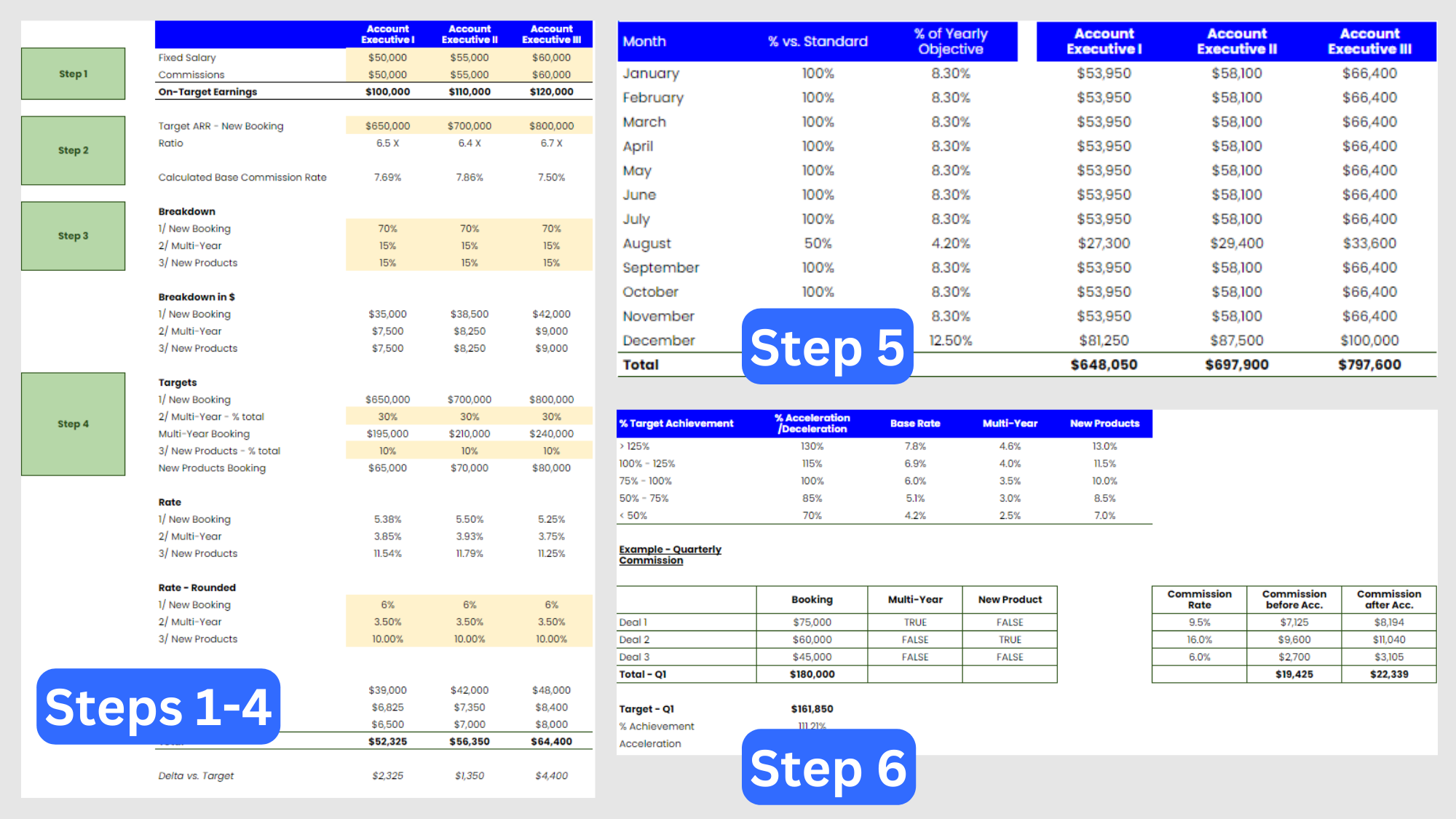
Sales Commission Structure Best Practices
A sales commission structure is a predetermined plan or framework to compensate sales reps based on their performance in generating revenue or closing deals.
It outlines the rules, criteria, and rates by which salespeople earn commissions for their sales activities.
The goal of a sales commission structure is to align the interests of sales professionals with the objectives of the organization, motivate them to achieve sales goals, and reward them fairly for their contributions to revenue generation.
Motivation: The Key to Sales Success
When it comes to sales, there’s no denying the power of a strong incentive.
The reality is that sales are a tough gig.
Your team is on the front lines, overcoming objections, building relationships, and closing deals.
In this challenging environment, a well-structured commission model can be just motivation they need to push harder and deliver results that impact your bottom line.
A good commission structure is a framework that encourages and rewards the right behaviors.
If it’s too easy, it won’t push your sales team hard enough.
If it’s too harsh, it could discourage them.
The goal is to find the right balance that motivates your team to exceed their sales goals.
Remember, a commission structure isn’t created for the finance or ops teams – it’s created for sales.
It’s about leveraging the best habits and behaviors that will drive sales success.
Keep it Simple, Keep it Clean
A common pitfall is overcomplicating the rules, ending up with a 20-page document.
Not only is this confusing for your sales team, but it also creates unnecessary friction when it comes to implementation.
The best structure is simple, straightforward, and easily explainable in 3 minutes – think of it as the ‘5-year-old test’.
If a 5-year-old can get it, you’re on the right track.
Reward the Right Habits
A commission plan isn’t just about compensating reps for their work – it should reflect your company’s priorities.
You don’t want your sales reps to devote their effort and time to tasks that may not be a top priority in the company.
Selling multi-year contracts? Prioritizing upfront payment? Launching a new product or targeting a specific customer category?
Your commission plan should incentivize your top priorities.
By adjusting the commission rates, you can guide your team toward the goals that matter most to your business.
Fairness is Key
You want to hit that ‘just right’ balance.
Too generous, and you might put a strain on your resources.
Too stingy, and you risk demotivating your sales team.
A fair commission plan rewards good performance, fosters motivation, and maintains harmony within your organization.
In the following sections, you’ll get a step-by-step process to design your own sales commission model that’s simple, fair, motivating, and aligned with your business goals.
Step 1: Define the On-Target Earning (OTE) Structure
On-target earnings, or OTE, is the total compensation a rep can expect to earn when they meet 100% of their sales quota.
It consists of their fixed base salary plus potential commission.
For instance, a salesperson with a salary of $100,000 and an equal amount in potential commission would have an OTE of $200,000.
If they hit their quota, they essentially double their salary.
Linking OTE to Sales Quotas
The potential commission is tied to the rep’s quota, or annual sales goal.
This quota measures their performance and determines their commission.
Continuing with our example, if the salesperson’s OTE is $200,000 and their quota is $1 million in Annual Recurring Revenue (ARR), they’d need to hit that $1 million mark to double their salary.
If they fall short, their commission shrinks proportionally. If they exceed it – that’s where accelerators come in, but we’ll get to that later.
Even though this might seem basic, it’s an essential first step.
Defining the right OTE and sales quota can set the tone for your entire commission plan.
Step 2: Define the Commission Rate
The base commission rate is the core of your commission structure.
It doesn’t involve any accelerators, decelerators, or thresholds.
Nor does it take into account particular incentives like selling multi-year contracts, obtaining upfront payments, or launching new products.
These additional elements will come into play later, right now we’re sticking to the basis.
The commission rate offers a simple, straightforward benchmark that your employees can understand and work towards, and your finance department can effortlessly calculate.
Calculate the Commission Rate
The formula is simple: Divide the target variable pay by the sales quota.
For example:
If you have a rep with an OTE of $200,000 (made up of a $100,000 base salary plus $100,000 in potential commission) and a sales quota of $1 million, the commission rate is calculated as follows:
Base Commission Rate = Target Variable Pay / Sales Quota = $100,000 / $1,000,000 = 10%
So, in this case, it is 10%.
Step 3: Define Sales Priorities for Your Sales Commission Structure
Sales priorities should align with your company’s overall objectives.
Are you launching a new product? If so, driving sales for that product becomes a priority.
Expanding into a new market? Then that new market should be at the top of the list.
If your goal is to boost upfront cash flow, securing upfront payments can be a priority.
Examples of Sales Priorities
Here are some examples of common sales priorities that can be reflected in your commission plan:
- New Product or Feature
If you’re launching a new product or feature, you may offer more (or less) commission to incentivize your sales team to push it.
- New Geography
If you’re expanding into a new market, you might introduce these territories into your commission plan to motivate sales in different regions.
- Upfront Payment
Encourage upfront payments by offering higher commissions for quarterly or yearly payments.
- Multi-Year Contracts
Compensate reps for securing long-term contracts.
- Contract Sizes
You may want to incentivize your team to secure larger (or smaller) contracts by offering a different commission rate.
- New vs. Existing Customers
Often, companies pay higher commissions on new business, which can be more challenging to land than upsells or expansions.
You can include factors such as the presence of a Sales Development Representative (SDR) or Business Development Representative (BDR) on a deal. However, I advise caution. This can lead to undesirable behavior and conflicts of interest.
It’s generally more effective to reward those who have contributed to the deal, but keep the commission percentage consistent for the salesperson, regardless of whether an SDR or BDR was involved.
Avoid factors such as sales seniority as sales priorities. Your salary structure should already account for this, and a sale’s value shouldn’t depend on the seniority of the salesperson who closed the deal.
Put Sales Priorities into Practice
In practice, you should select one or two priorities each year to focus on.
For each priority, you’ll define how to adjust the commission rate when contracts meet the specified criteria. We’ll delve into the specifics of this in the next step.
Step 4: Define Objectives for the Selected Priorities
After identifying the key priorities for your sales team that align with your broader business goals, the next step is to clearly define objectives for each of these priorities.
The purpose of this step is to translate your priorities into tangible, measurable goals.
By setting specific objectives, you make it easier for your sales team to understand what they need to achieve and how their efforts will contribute to the company’s overall success.
Align Priorities with Sales Targets
A practical approach to defining objectives is to think in terms of percentages of total sales.
For example, if your priority is to increase the sale of multi-year contracts, consider what percentage of total sales you want these contracts to represent.
To do this, you’ll need to look at your historical data and consult with your sales leadership team to understand realistic goals.
Set SMART Goals
Let’s say you’ve historically sold about 10% of multi-year contracts, but you’d like to push this up to 20% for the next year. If your total sales objective is $1 million, that means you’re expecting 20% of that – or $200,000 – to come from multi-year contracts.
Remember, the goals you set for each of your priorities should be SMART.Specific, Measurable, Achievable, Relevant, and Time-bound.
In this example, your SMART goal might be: “Increase profits from multi-year contracts to $200,000 by the end of the fiscal year.”
Repeat the Process for Each Priority
Once you’ve defined the objectives for one priority, repeat the process for the other. The key is to be clear and explicit about what you’re expecting from your sales team.
This is a crucial step in your commission plan.
By clearly defining the objectives for each priority, you’re setting your sales team up for success, aligning their efforts with your business strategy, and ensuring that their hard work will directly contribute to your company’s most important goals.
A well-defined target is much easier to hit!
Set a Commission Rate for each objective
The final step is to define the commission rate that will be paid out to the reps, based on what is sold.
- Determine the percentage breakdown of the total yearly commission for each objective.For example, allocate 70% to booking, 20% to upfront payment, and 10% to multi-year deals.
- Set targets for each objective.For instance, aim for 50% of sales to be upfront payments. If your yearly goal is $1M ARR, this means you expect the team to close $500K with upfront payments.
- Establish a commission rate for each objective.Simply divide the target commission by the target value for the objective.
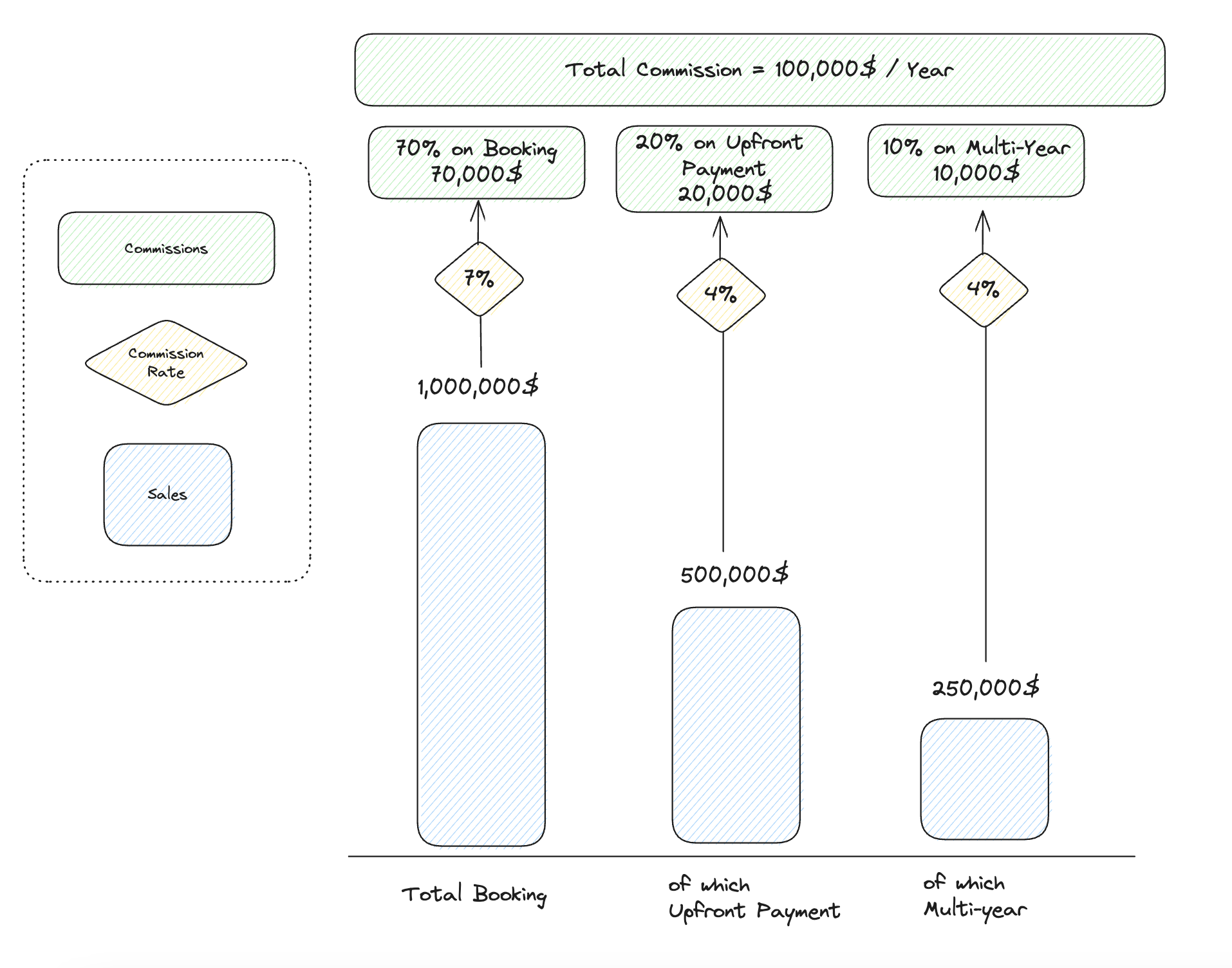
Step 5: Define Commission Periods: Month, Quarter, Year, etc.
This aspect of your commission plan is key to its success, as it directly impacts how frequently your sales team can expect to receive their incentives, which influences their motivation and performance.
Set Sales Objectives: Yearly vs. Quarterly
While sales objectives are usually defined yearly, some companies opt for a more variable approach, with objectives that change each quarter.
However, frequently changing objectives can require a substantial amount of maintenance and can potentially lead to confusion or frustration within your sales team, quite frankly it’s not worth it.
A more practical approach might be to set yearly objectives, which can be broken down into quarters or months to accommodate seasonal variations in your sales cycle.
For example, if your business tends to be slower in August and busier in December, you might want to adjust your monthly sales targets accordingly.
Example of Seasonality:
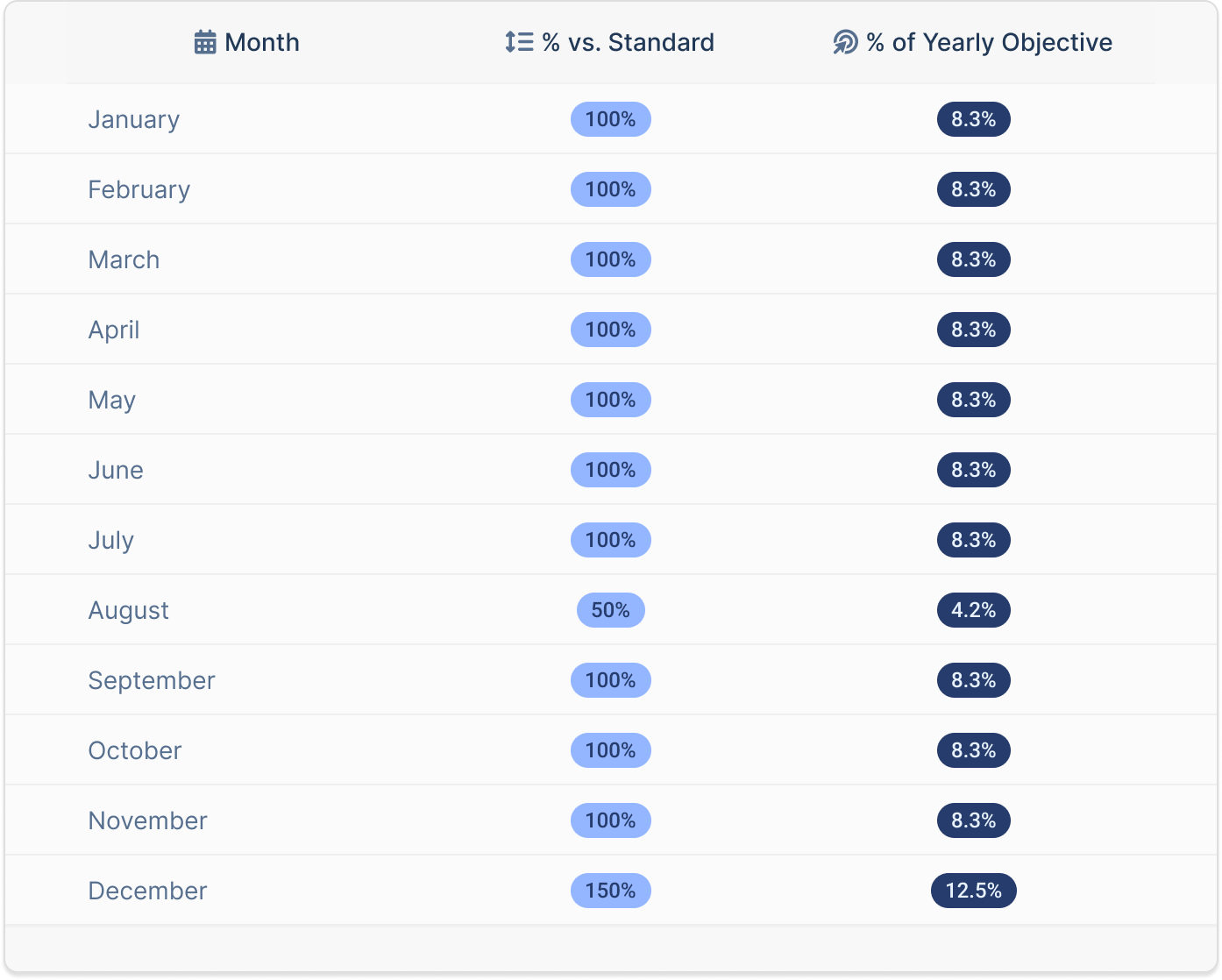
Decide on the Frequency of Commission Payments
An important aspect of your commission plan is the frequency at which commissions are paid out. It’s often beneficial to pay commissions as frequently as possible as this can drive salespeople’s motivation and focus on shorter-term goals.
However, factors such as the length of your sales cycle might prevent you from making monthly commission payments.
As a rule of thumb, it’s good practice to align commission payments with your sales cycle but avoid extending the commission period beyond a quarter.
Example of Commission Payment Frequency Based on Sales Cycle:

Here, ACV stands for Annual Contract Value, which refers to the average yearly contract revenue from each contracted customer.
Paying Commissions Upon Deal Closure
Another good practice is to pay commissions whenever deals are signed, and then calculate accelerators or decelerators (which we will discuss later) at the end of each commission period.
This approach essentially treats these payments as an advance on the commission, but it allows your sales team to be rewarded more immediately for their hard work, which can drive motivation and performance.
Step 6: Define Acceleration, Deceleration, and Thresholds
Thresholds
A threshold is the minimum level of sales that a salesperson needs to achieve before they start earning a commission. Some companies set the threshold at a level that covers the cost of the salesperson.
For example, if a salesperson is paid $100K per year and costs $125K including overheads, they will start receiving commissions once they achieve $125K in sales.
However, while this approach may be logical from a financial perspective, it can potentially reduce the motivation of salespeople.
Mainly because it could lead to behaviors such as “fridge” deals, where salespeople delay closing deals until the next period if they anticipate they won’t reach the threshold in the current period.
This can delay revenue and even result in lost deals. Hence, it’s generally recommended to avoid using thresholds.
Acceleration and Deceleration
Acceleration and deceleration in a sales commission plan refer to increasing or decreasing the commission rate based on quota attainment.
A common method to implement this is by creating a table that correlates quota attainment ranges with commission rates.
- Example of Acceleration/Deceleration Table:
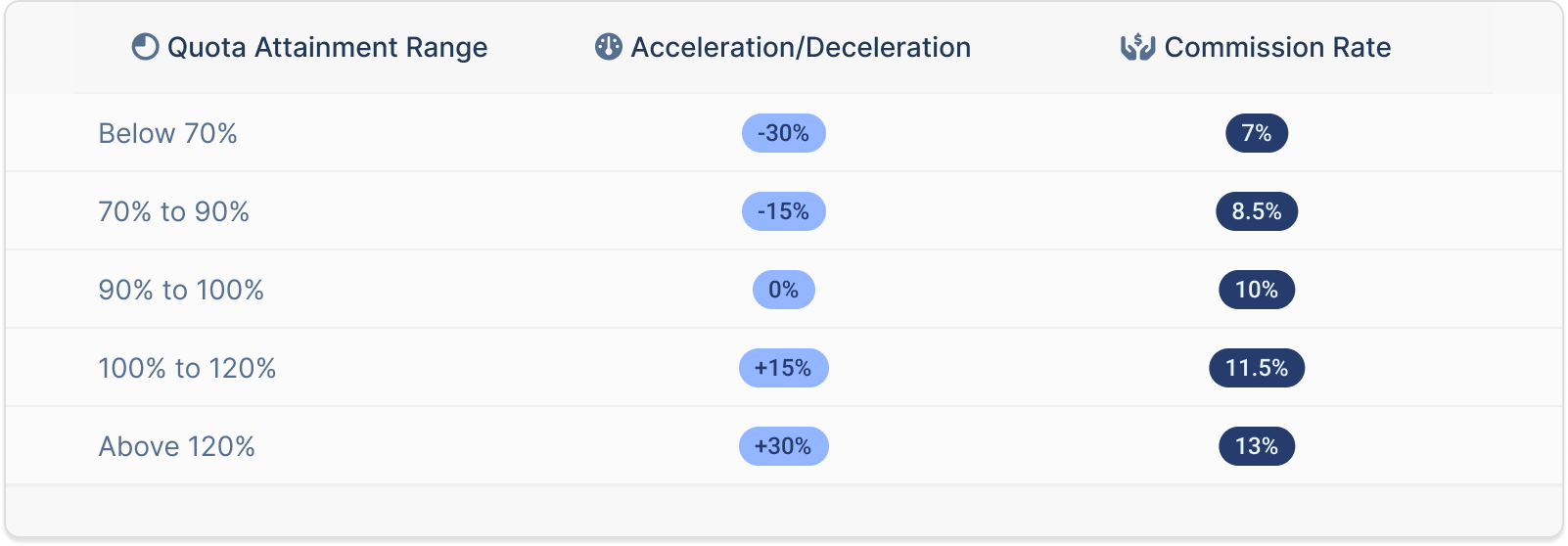
- Applying Acceleration/Deceleration
The next step is deciding whether the acceleration or deceleration applies to the entire commission or just the base rate.
For simplicity, it’s generally recommended to apply it to the entire commission.
Here’s an example:
- Your company pays a 10% base commission rate and 15% on multi-year deals.
- A salesperson with a $1M quota sells for $1.3M (130% quota attainment).
- They sold $800K on yearly contracts and $500K on multi-year contracts.
- The commission will be $80K for yearly contracts (800K * 10%) and $75K for multi-year contracts (500K * 15%) = $155K commission before acceleration.
- The acceleration for 130% quota attainment is +30%.
Now let’s look at two methods of applying the acceleration:
- Applied to the whole commission: $155K * 1.3 = $201.5K total commission.
- Applied only to the base: ($1.3M * 10%) * 1.3 = $169K total commission.
Bulk vs. Tiers
Finally, keep in mind that accelerations and decelerations can be applied in bulk or in tiers.
- Bulk application occurs when the acceleration or deceleration percentage is based on total quota attainment.For instance, if someone reaches 130% of their quota, they receive a 30% acceleration on the entire amount.
- Tiers involve applying different commission rates for different ranges of quota attainment.For example, for sales up to 70% of the quota, the salesperson receives 7%, for sales between 70% and 90% of the quota, they receive 8.5%, and so on.
While bulk application is simpler and avoids the need to track sales within different ranges, it can create threshold effects where a slight increase in sales leads to a significant jump in commission.
As always, simplicity is key, and it’s important to remember that no commission plan can be perfect.
Step 7: Write and Communicate the Sales Commission Plan
Creating the right commission plan involves multiple steps, from defining objectives to setting up acceleration or deceleration scales.
The final step in this process is to articulate this plan effectively and concisely.
The goal is to provide a transparent and easily understandable document that guides your sales team and eliminates room for interpretation.
This document will be a formal and legally binding contract between the company and the salesperson.
Some factors you should take into consideration when setting the commission are:
- Define terms
Start by defining key terms used in the commission plan.
These could be terms like MRR (Monthly Recurring Revenue), New Customer, ACV (Annual Contract Value), and any other terms related to sales commissions at your company.
- Highlight key components
Clearly state the On Target Variable, Quota, and commission rates. Also, identify the key sales priorities for the period.
- Keep it simple and clear
Make sure the plan is simple, concise, and easy to understand. Remove unnecessary jargon and complexity.
- Be precise
The commission plan needs to be detailed enough to avoid ambiguities and possible interpretations.
- Group variables
Consolidate all variables in one place in the document for easy editing. This can be the part where you specify individual quotas, commission rates, etc. Refer to these consolidated variables throughout the document as needed.
Now, let’s see a template for a Sales Commission Plan:
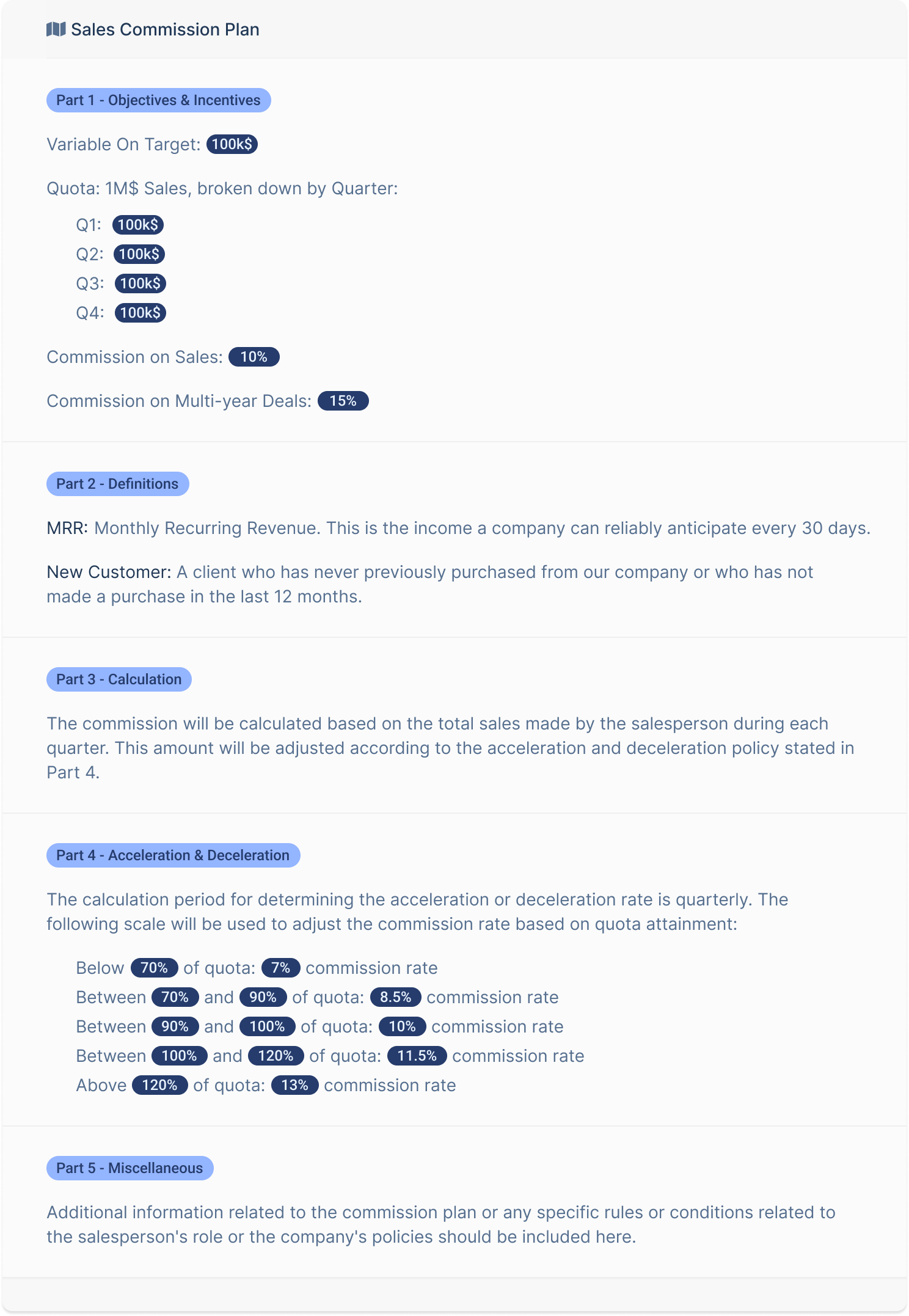
Additional Common Practices
You can consider using the following mechanisms
- Churn Clawback is a mechanism that enables you to recover paid commissions if a customer churns within a specified period.
For instance, you can set up a Commission Clawback for any churn within the first 3 or 6 months after the signature.
Be careful, as the calculation of the Churn Clawback needs to be well-defined.
There are three possible methods:
→ Subtract the amount of the churned deal from the month’s results in which the churn occurred.
→ The commission that was paid may be subject to clawback, plus or minus any acceleration or deceleration that may have occurred.
→ The commission paid may be clawed back without taking into consideration any eventual acceleration/deceleration that may have been incurred.
- “SPIFF” (Sales Program Incentive Funds) allows for rewarding specific behaviors or outcomes over a specific time frame.
For instance, you can decide on quarterly SPIFFs to reward new opportunities opened in the automotive industry.
SPIFFs are usually on top of regular commissions and aim to reward behaviors expected over a short period of time.
- “Commission Draw” is a pre-defined amount of money that a newly hired Sales rep is given against future commissions.
Commission draw allows sales to maintain a certain level of income when changing jobs.
There are two reasons why Commission Draws exist:
- Lost opportunityWhen a Salesperson leaves their current company, they may lose future commissions, potentially leaving behind a pipeline of deals for which they will not earn a commission.
- Cover for ramp periodWhen a Salesperson joins a new company, they will need to learn the product and build a pipeline. This means they may not receive commissions for a period of time.
This is why it’s common practice, particularly when hiring senior salespeople, to offer a commission draw.
The draw can be either recoverable or non-recoverable.
A non-recoverable draw guarantees a minimum commission for the Salesperson, while a recoverable draw means they need to pay back the amount over time.
I recommend using recoverable draws as they encourage Salespeople to perform well.
On the other hand, non-recoverable draws do not incentivize Salespeople to perform their best.
Key Takeaways
In a nutshell, your sales commission structure will be the framework against which your sales reps will measure their work in the company.
It should be well-defined, clear, and concise to ensure everyone is on the right page and you can eliminate risks or friction inside your team.
By setting and achievable, yet challenging commission plan, reps will be motivated to achieve as much as they can. It’s a win-win situation.
That concludes our discussion on Commission Plans.
I hope you found this article helpful.
And if you’re wondering about Sales Commission Software, we’ve got you covered!
If you have any questions or comments, please don’t hesitate to contact me directly at charles@lempire.co.

